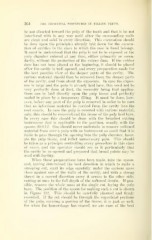Page 706 - My FlipBook
P. 706
364 THE TECHNICAL PROCEDUEES IN FILLING TEETH.
be not directed toward the pulp of the tooth and that it be not
interfered with in any way until after the surrounding walls
are clean and solid in every direction. This excavation should
be done upon the principles already laid down for the excava-
tion of cavities in the class to which the case in hand belongs.
It must be understood that the pulp is not to be exposed or the
pulp chamber entered at any time, either primarily or secon-
darily, without the protection of the rubber dam. If the rubber
dam has not been placed at the beginning, it should be placed
after the cavity is well opened, and every preparation made for
the best possible view of the deeper parts of the cavity. The
carious material should then be I'emoved from the deeper parts
of the cavity, and from about the exposure. In case the expos-
ure is large and the puli) is already laid bare, this need not be
very perfectly done at first, the necessity being that applica-
tions can be laid directly upon the pulp tissue and perfectly
sealed in place by a temporary filling. It must be done, how-
ever, before any part of the pulp is removed in order to be sure
that no infectious material be carried from the cavity into the
root canals. In case the pulp is covered with carious material,
only, this should be removed and the tissue of the pulp laid bare.
In every case this should l>e done with the broadest cutting
instrmnent that is aj^plicable to the position, usually with the
spoons 20-9-12. One should never undertake to remove softened
material from over a ]mlp with an instrument so small that it is
liable to pass through the opening into the pulp chamber, lacer-
ate the pulp tissue, and inflict unnecessary pain. This should
be taken as a principle controlling every procedure in this class
of cases, and the operator should see to it particularl}' that
the cavity be so opened and prepared that broad points may be
used with facility.
When these preparations have been made, take the spoon,
and, having determined the best direction in which to make a
sweeping cut, start its edge carefully under the carious mass
close against one of the walls of the cavity, and with a strong
thrust in a curved direction carry it across to the other side,
cutting at once to the full depth of the softened dentin. If pos-
sible, remove the whole mass at the single cut, hiying the pulp
bare. The position of the spoon for making such a cut is shown
in Figui'e 132. This shoukl be car(>fully ]»lnuupd and finuly
executed. If the cut should be through the superficial portions
of the pulp, excising a portion of the tissue, it is just as well,
for when the hemorrhage has ceased, we are sure of the best


